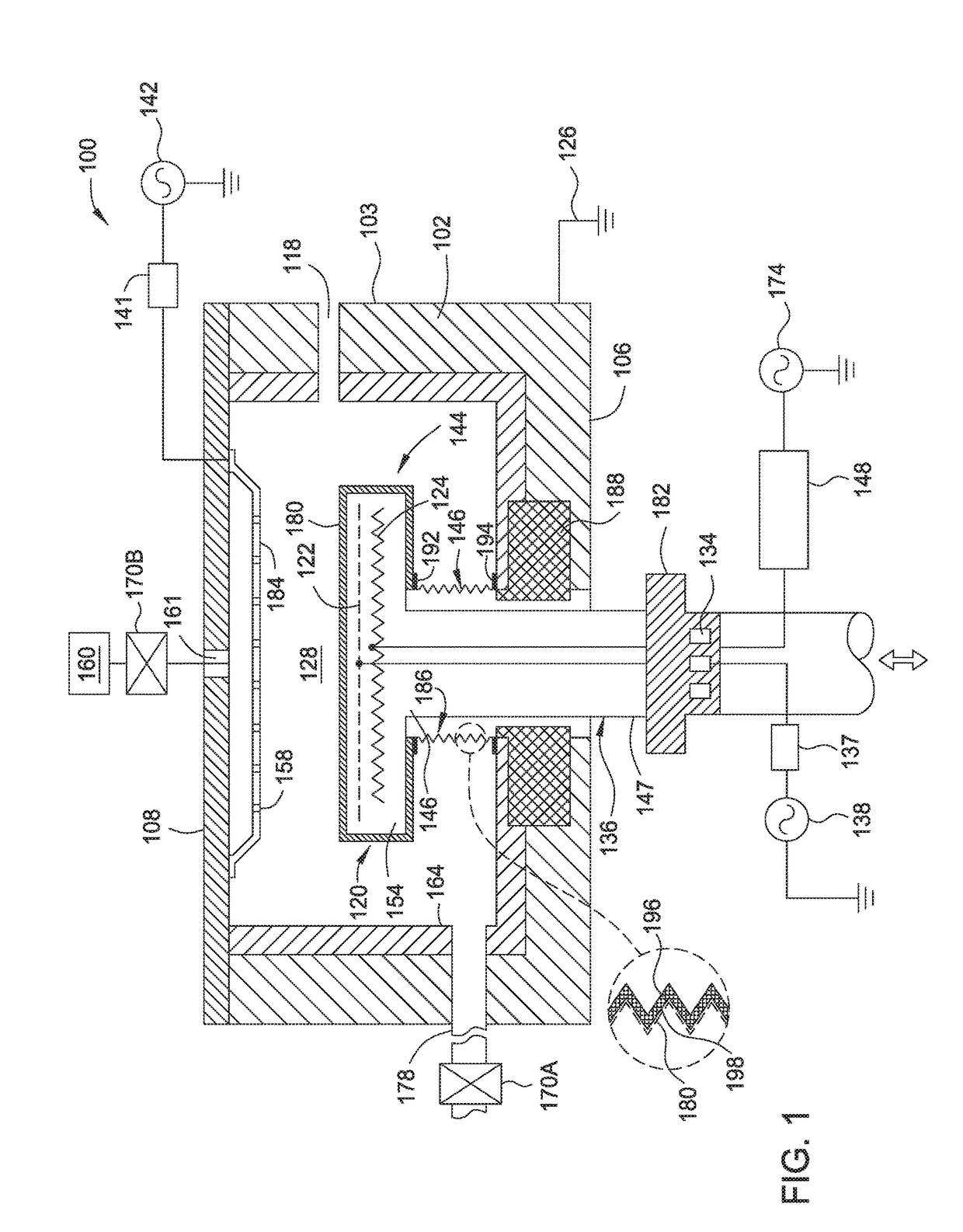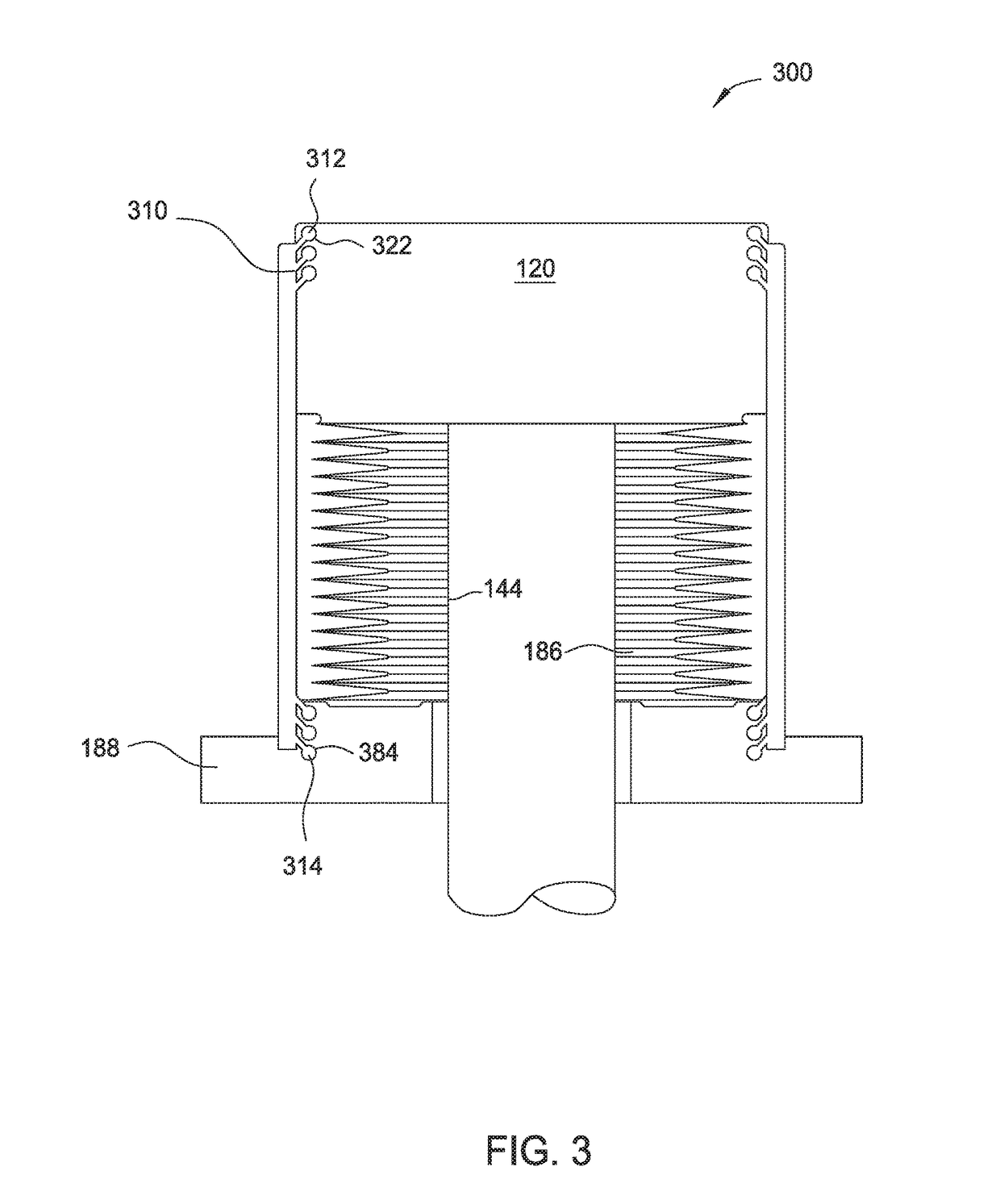Corrosion control for chamber components
a technology of corrosion control and chamber components, applied in the direction of spindle sealing, mechanical equipment, coatings, etc., can solve the problems of process contamination and process skew
- Summary
- Abstract
- Description
- Claims
- Application Information
AI Technical Summary
Problems solved by technology
Method used
Image
Examples
first embodiment
[0042]In a first embodiment, the coating 180 and the shield 210 are used to protect the substrate support 120, the flange 188, and bellows 186. The substrate support 120 and bellows 186 may be formed from nickel-chromium alloy. The shield 210 may be formed from aluminum, such as 6061-T6. The coating 180 may be formed from a polytetrafluoroethylene (PTFE), or parylene C or D material. The coating 180 may be from about 0.5 microns to about 50.0 microns, such as about 5 microns. The polytetrafluoroethylene (PTFE), or parylene C or D material may be chemical vapor deposited to form multiple layers, and may optionally have a bonding layer disposed therebetween. The coating 180 may be a very thin and conformal top layer, and for example, may be deposited using physical vapor deposition and / or chemical vapor deposition. The coating 180 is formed on the substrate support 120 and the bellows 186. The coating 180 on the substrate support 120 may be continuous and extend to and cover the bello...
second embodiment
[0043]In a second embodiment, the coating 224 on the bellows 186 is formed from a diamond-like carbon or a ceramic material such as yttria stabilized zirconia or alumina or AsMy. The coating 224 may have a thickness of about 0.5 microns to about 50.0 microns, such as about 5 microns for DLC and about 25 microns for ceramic. The diamond-like carbon or ceramic material may be chemical vapor deposited with multilayers having a bonding layer in between. A very thin and conformal top layer may be deposited using physical vapor deposition or chemical vapor deposition to cover any pours. The coating 220 of the substrate support 120 may be formed from polytetrafluoroethylene (PTFE), or parylene C or D, the diamond-like carbon or a ceramic material or a metal, such as a nickel coating. The coating 220 may have a thickness of about 0.5 microns to about 50.0 microns, such as about 12 microns. The coating 220 may be plasma sprayed with multilayers having a bonding layer in between and a thin co...
third embodiment
[0044]In a third embodiment, the bellows 186 are formed from Inconel 625 and protected from the corrosive processing gases and high temperatures by a flexible shield 310. FIG. 3 illustrates a side plan view of another substrate support assembly 300 for use in the plasma processing chamber 100. The substrate support assembly 300 has the flexible shield 310 for corrosion protection of the bellows 186. The flexible shield 310 may be made from polytetrafluoroethylene (PTFE) or other suitable material. The flexible shield 310 may have a snap seal 312 at one end and a second snap seal 314 at a second end. The substrate support 120 may have a feature 322 for interfacing with the snap seal 312. Additionally, a second feature 384 may be disposed on the flange 188 for interfacing with the second snap seal 314. The snap seals 312, 314 and features 322, 384 may be in the form of a male / female interface, ball and socket, or other two part fastening system for sealingly joining to components. The...
PUM
| Property | Measurement | Unit |
|---|---|---|
| thickness | aaaaa | aaaaa |
| diameter | aaaaa | aaaaa |
| diameter | aaaaa | aaaaa |
Abstract
Description
Claims
Application Information
 Login to View More
Login to View More - R&D
- Intellectual Property
- Life Sciences
- Materials
- Tech Scout
- Unparalleled Data Quality
- Higher Quality Content
- 60% Fewer Hallucinations
Browse by: Latest US Patents, China's latest patents, Technical Efficacy Thesaurus, Application Domain, Technology Topic, Popular Technical Reports.
© 2025 PatSnap. All rights reserved.Legal|Privacy policy|Modern Slavery Act Transparency Statement|Sitemap|About US| Contact US: help@patsnap.com



